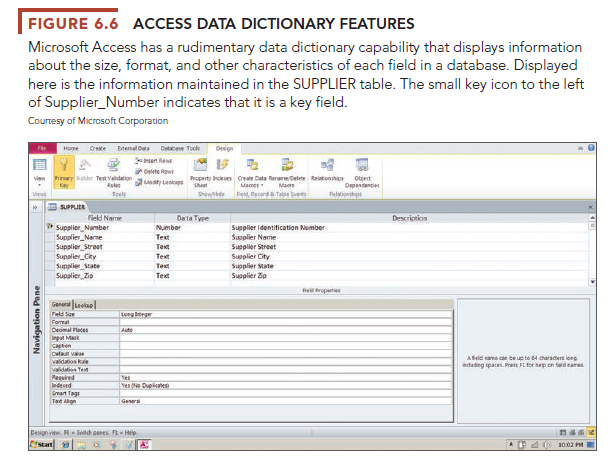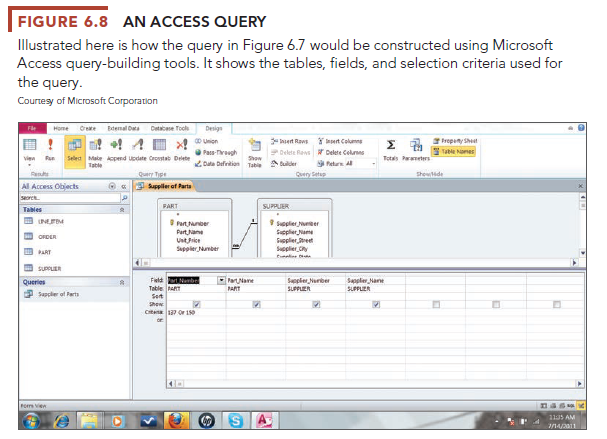A DBMS includes capabilities and tools for organizing, managing, and accessing the data in the database. The most important are its data definition language, data dictionary, and data manipulation language.

DBMS have a data definition capability to specify the structure of the content of the database. It would be used to create database tables and to define the characteristics of the fields in each table. This information about the database would be documented in a data dictionary. A data dictionary is an automated or manual file that stores definitions of data elements and their characteristics.
Microsoft Access has a rudimentary data dictionary capability that displays information about the name, description, size, type, format, and other properties of each field in a table (see Figure 6.6). Data dictionaries for large corporate databases may capture additional information, such as usage, ownership (who in the organization is responsible for maintaining the data), authorization, security, and the individuals, business functions, programs, and reports that use each data element.
1. Querying and Reporting
DBMS includes tools for accessing and manipulating information in databases. Most DBMS have a specialized language called a data manipulation language that is used to add, change, delete, and retrieve the data in the database. This language contains commands that permit end users and programming specialists to extract data from the database to satisfy information requests and develop applications. The most prominent data manipulation language today is Structured Query Language, or SQL. Figure 6.7 illustrates the SQL query that would produce the new resultant table in Figure 6.5. You can find out more about how to perform SQL queries in our Learning Tracks for this chapter.

Users of DBMS for large and midrange computers, such as DB2, Oracle, or SQL Server, would employ SQL to retrieve information they needed from the database. Microsoft Access also uses SQL, but it provides its own set of user- friendly tools for querying databases and for organizing data from databases into more polished reports.
In Microsoft Access, you will find features that enable users to create queries by identifying the tables and fields they want and the results and then selecting the rows from the database that meet particular criteria. These actions in turn are translated into SQL commands. Figure 6.8 illustrates how the same query as the SQL query to select parts and suppliers would be constructed using the Microsoft Access query-building tools.
Microsoft Access and other DBMS include capabilities for report generation so that the data of interest can be displayed in a more structured and polished format than would be possible just by querying. Crystal Reports is a popular report generator for large corporate DBMS, although it can also be used with Access. Access also has capabilities for developing desktop system applications. These include tools for creating data entry screens, reports, and developing the logic for processing transactions.
Source: Laudon Kenneth C., Laudon Jane Price (2020), Management Information Systems: Managing the Digital Firm, Pearson; 16th edition.

I truly appreciate this post. I have been looking all over for this! Thank goodness I found it on Bing. You have made my day! Thanks again